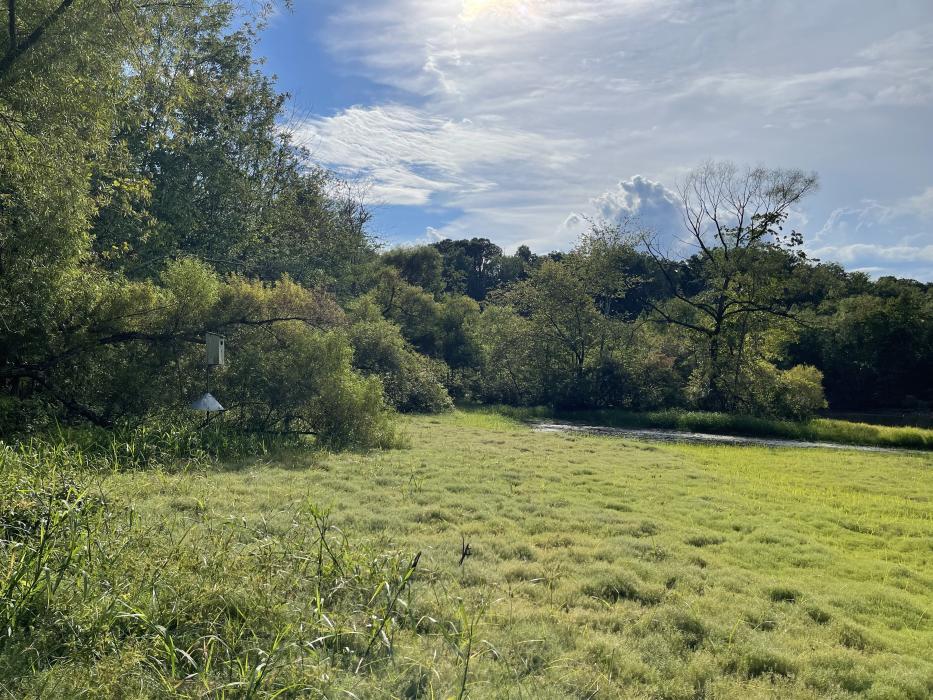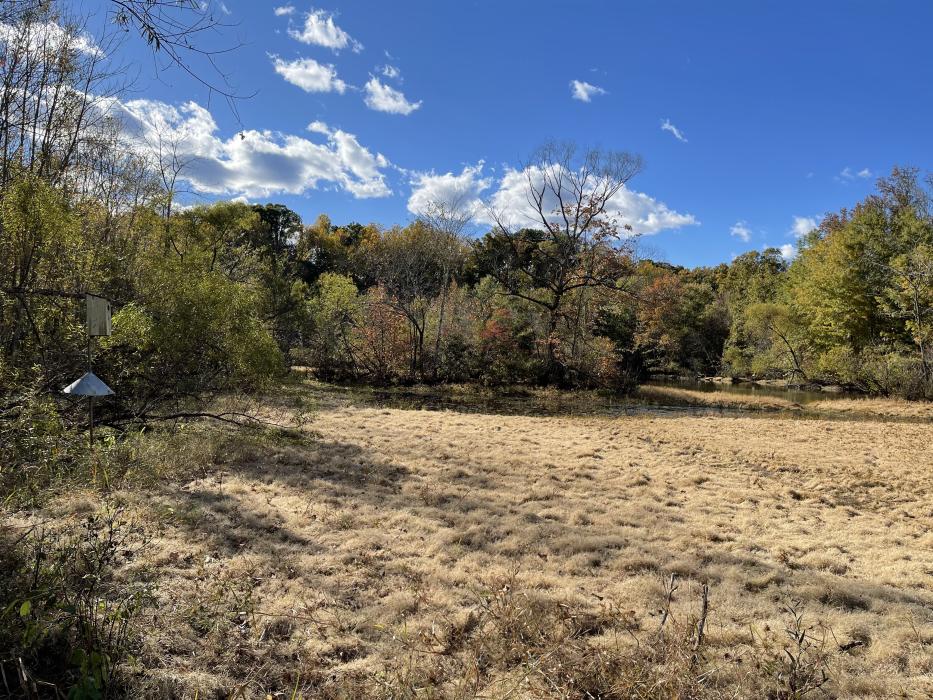Picture One

Observations
A photographer took the first picture at a random spot in our school’s ecological preserve to observe the elements of nature. The picture portrays natural green vegetation, making the spot beautiful and spontaneous. The grass is green and covers the entire land, indicating adequate rainfall. Green grass depicts healthy vegetation and a thriving environment. The picture also captures a rain gauge used to measure the average rainfall in a particular region within a given period. The spot where the photographer captured the picture complements the measure of rainfall by providing an ecological impact of different amounts of rainfall. People observing the picture can see the beauty of nature through the thick forests and natural flowing springs. Living organisms thrive in this environment, although the picture does not capture animals.
The trees in the picture are green and healthy, and a small river flows between the trees. The trees also show that the environment supports biodiversity growth and development. Different vegetation types cover the forest, including shrubs, hardwood trees, river bank vegetation, and green grass. Vegetational biodiversity also portrays that the climate supports the growth of different living organisms. The river is responsible for the green nature of vegetation in this spot. The picture shows the sun shining on the grass at an angle while the sky is clear, indicating that the photographer took the picture in the morning. The clouds show a combination of clear blue and grey clouds responsible for rainfall. The observation from the first picture shows how nature thrives when there is adequate rainfall.
Meanings
A photographer took the first picture at the school’s ecological reserve and portrayed the significance of rainfall on the natural vegetation. The rainy season, also known as the wet season, is when a region receives an average amount of rainfall. Adequate rainfall influences precipitation, which makes vegetation appear green and thriving. The average amount of precipitation during the rainy season is approximately 60 millimeters. The picture also captured the rain gauge, a weather instrument measuring the average rainfall. The rainy season also improves ecological life by improving the quality of water, air, and land. The water in the first picture appears fresh and can support the survival of aquatic organisms. Living organisms that live within the ecosystem also consume fresh water.
The rainy season also improves air quality by removing dust particles. The picture also shows a seasonal savanna forest that depends on rainfall to thrive. The forest plays a critical role in attracting more precipitation in the area. However, during the dry season, the trees shed their leaves to conserve water by reducing water loss through the leaves. The picture depicts an image that is difficult to find in the current generation. Trees are critical for ecological welfare because they attract rainfall (Turner‐Skoff & Cavender, 2019). However, people have cut down a significant amount of forest cover, resulting in adverse climatic impacts.
Human practices are critical in determining the type of climate of a specific region. However, some regions experience wet and dry seasons alternating. The picture shows the wet climate periods when the vegetation is green and thriving. The image allows us to compare and contrast the dry and wet seasons. The school’s ecological preserve is situated in a strategic place where people can study different attributes of nature. Therefore, the first picture critically depicts the significance of adequate rainfall on the natural vegetation.
Picture Two

Observations
A photographer took the second picture at the same spot in our school’s ecological preserve where he took the first picture. The picture portrays the adverse impacts of harsh climate observed through dry vegetation. The dry vegetation makes the area look unattractive and unfit for human survival. The picture captures the rain gauge with a more precise focus because the vegetation is dry. The first picture’s green vegetation covers parts of the rain gauge. However, someone can easily see and identify the equipment in this second picture. Brown dry grass covers the land, an indication of inadequate rainfall during the season when the photographer took the picture.
The picture shows the adverse ecological impacts of dry climate on the natural vegetation. A dry climate prevents the growth of plant and animal diversity. The harsh climate kills many organisms, leaving only the ones that can survive the harsh weather. The trees in the picture are scattered and have shed leaves. Trees also have discolored leaves, making the environment look hot and inhabitable. The stream of water is visible in the picture, but the amount of water is low compared to the first picture. The sun shines on the grass at an angle, and the sky is clear and dominated by blue clouds. The shadows the trees cast suggests that the photographer must have taken the picture in the afternoon. The observation from the picture shows how nature suffers from inadequate rainfall.
Meanings
The photographer took the second picture in the same spot as picture one but during a different season. He captured the image during the dry season when the annual rainfall levels are below the expected average. Inadequate rainfall affects vegetation growth, which sheds off leaves and appears brownish-yellow. The average rainfall during the dry season is below 20 millimetres annually. The dry weather impacts vegetation and animals because animals depend on vegetation for survival. Inadequate rainfall has also reduced the water level in the area’s small stream. The temperatures experienced during the dry season are summer, and the climate is typical in the tropics. When the dry season becomes harsh and extreme, it results in drought characterised by dried rivers, low humidity, and loss of grazing lands for wildlife.
The second picture also shows the impacts of climate change on our ecosystem. Human activities have altered the regular climatic seasons and exposed the environment to extreme climates. Deforestation and pollution are the two activities that have altered the climate. People have cut trees and reduced the forest cover, which attracts rainfall and thus influences the dry season. Production activities have also polluted the land, air, and water by exposing toxic substances in the ecosystem (Chae & An, 2018). The image depicts the adverse impacts humans will face if they continue engaging in activities that degrade the environment.
Comparing pictures one and two encourages people to embrace ecological conservation practices such as planting trees, cleaning rivers, and reducing air pollution. Therefore, the second picture critically depicts the adverse impacts of extreme weather climates. However, humans can prevent extreme climates by increasing public awareness of the significance of preserving the ecosystem. Every person should take responsibility for caring for the environment to prevent extreme weather conditions.
References
Chae, Y., & An, Y. J. (2018). Current research trends on plastic pollution and ecological impacts on the soil ecosystem: A review. Environmental Pollution, 240, 387-395. Web.
Turner‐Skoff, J. B., & Cavender, N. (2019). The benefits of trees for livable and sustainable communities. Plants, People, Planet, 1(4), 323-335. Web.